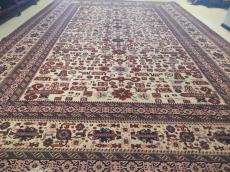|
|
TODAY.AZ / Arts & Entertainment
Country's largest carpet woven in Gabala
14 July 2021 [10:15] - TODAY.AZ

By Azernews
By Laman Ismayilova
Azerkhalcha OJSC has presented the largest carpet of the last two years woven in Gabala.
The 24-square-meter (4x6) carpet belonging to the Guba school weighs 57.2 kilograms. Aygun Nasirova, Khatira Shakarkhanova and Ulviya Sariyeva started weaving the Pirabadil carpet in 2018 as part of the workshop held by Azerkhalcha OJSC.
However, the carper weaving process stopped amid coronavirus pandemic. For a whole year, the carpet was carefully looked after in order to protect it from moths.
Finally, the carpet weavers resumed the working process this April and finished the carpet in July.
Carpet-weaving art is considered an integral part of Azerbaijani culture and craftsmanship. Azerbaijani carpets are stored in many prestigious museums and private galleries around the world.
In 2010, Azerbaijani carpet weaving art was included in UNESCO's Intangible Heritage List.
According to their technical aspects, Azerbaijani carpets are classified as flat-woven (pileless) and knotted (pile). The flat-woven carpets are linked to the earlier period of carpet weaving. There are several kinds of pileless carpets such as Shadda, Verni, Jejim, Zilli, Sumakh, Kilim and Palas.
Shadda is a flat weave carpet, made primarily in Nakhchivan, Agdam, Gubadly, Agjabadi. The artistic composition of shadda made by complicated whipping, as well as its constituents have a complex form.
One of the most widely spread types of the flat-weave carpet is "verni". The key pattern of "verni" is the S-element. Its shape varies, it may resemble both figure 5 and letter S. This element means "dragon" among the nomads and “water” among the village people. According to ancient beliefs, a dragon featuring carpet would protect the family from foul weather. Agjabadi, Barda, Aghdam, Nakhchivan are the centers of this type of pileless carpets.
Jejims are woven on simple horizontal looms by narrow stripes 30–35 cm wide and 15–10 cm long. The resulting product is a cloth to be used as a wall carpet, a bedding coverlet, or curtains.
The major jejim production centers are Barda, Nakhchivan, Zangilan, Shusha, Shamakha.
Zilli carpet is characterized by stylized forms of animals and vegetal elements. In terms of their composition and pattern the Azerbaijani zillis are very diverse. They feature images of large elements in the shape of big lozenges, paired horns, and various stylized elements.
The Sumakh carpets have become widely spread and recognized over the last few centuries. Since the 18th century, they have been made in the country's Guba and Gusar regions.
The Sumakh carpets feature the diverse stylized vegetal motifs, various geometrical elements such as large hexahedral, square, rhomboid medallions.
Kilim is the most widespread type of flat-woven carpets. They are made by passing the weft through the warp using the technique of compound interweaving. Kilim is characterized by a slot-like gap (opening) around the geometrical patterns.
The technique of kilim weaving predetermines the pattern shapes in the form of a lozenge, triangle, and trapezium. Images of animals, birds and humans are geometrized in kilims. Kilims of different regions are distinguished by their composition, pattern, and colors. In terms of their technical peculiarities, kilims can be classified into five major groups based on the area of production: Kazakh, Karabakh, Absheron, Shirvan and Tabriz kilims.
Palas is one of the widely spread flat-weave carpets. The palas weaving process consists in passing the weft through the warp by a simple technique.
The weavers decorate the palas by traditional patterns in the form of horizontal stripes commonly used throughout Azerbaijan. As a rule, the palas is not framed by a border.
URL: http://www.today.az/news/entertainment/207928.html
 Print version
Print version
Connect with us. Get latest news and updates.
See Also
- 09 January 2026 [14:35]
Azerbaijan prepares for centennial of first Turkological Congress - 09 January 2026 [12:42]
Safavid-era coins unearthed in Aghsu reveal traces of empire's ancient trade - 09 January 2026 [10:00]
National Drama Theatre unveils new historical play “L?ng” - 08 January 2026 [13:24]
Music Arts Entrance Exams: What you need to know for 2026/2027 - 08 January 2026 [12:31]
Baku to host candlelight concert with Waltzes by Tchaikovsky, Strauss, and Shostakovich for first time - 08 January 2026 [12:01]
Nizami Ganjavi's words set tone for harrowing tale of survival and resilience - 07 January 2026 [13:56]
Bulbul Memorial Museum honors Rashid Behbudov's musical legacy - 07 January 2026 [12:04]
Chamber music concert wows audience with striking performances - 06 January 2026 [14:40]
Leyla Aliyeva visits Sultan Qaboos Grand Mosque in Muscat - 06 January 2026 [14:30]
Leyla Aliyeva visits Oman Tourism Development Company
Most Popular
 Turkiye’s Togg inspires new vision for domestic automotive industry
Turkiye’s Togg inspires new vision for domestic automotive industry
 Success that no one has managed to repeat - five years after Azerbaijan's Victory
Success that no one has managed to repeat - five years after Azerbaijan's Victory
 Azerbaijan's military might is only guarantor of peace in region
Azerbaijan's military might is only guarantor of peace in region
 Finland sets record electricity consumption
Finland sets record electricity consumption
 Essence of Armenian opposition is in one picture
Essence of Armenian opposition is in one picture
 Trump says US control of Venezuela will last “much longer”
Trump says US control of Venezuela will last “much longer”
 Azerbaijan, Syria move to establish Joint Business Council
Azerbaijan, Syria move to establish Joint Business Council
